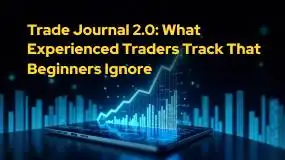简体中文
繁體中文
English
Pусский
日本語
ภาษาไทย
Tiếng Việt
Bahasa Indonesia
Español
हिन्दी
Filippiiniläinen
Français
Deutsch
Português
Türkçe
한국어
العربية
Trend Following vs. Counter-Trend Trading: Which is Right for You?
Abstract:Two prominent strategies often compete for the attention of traders: trend following and counter-trend trading. Each method has its strengths and weaknesses, and understanding them can help you choose the approach that aligns best with your trading style and risk tolerance.

Two prominent strategies often compete for the attention of traders: trend following and counter-trend trading. Each method has its strengths and weaknesses, and understanding them can help you choose the approach that aligns best with your trading style and risk tolerance.
Trend Following: Pros and Cons
Pros:
Capitalizing on Momentum:
Trend-following strategies aim to capture gains by riding established market trends. When a trend is in place, prices tend to continue moving in that direction, providing profit opportunities.
Clear Signals:
Trend followers often use technical indicators, such as moving averages and trend lines, which provide clear entry and exit signals. This can simplify decision-making and help traders stay disciplined.
Higher Win Rate:
Many trend followers report a higher win rate because they trade in the direction of the market, reducing the likelihood of premature exits.
Cons:
Late Entry Risk:
Trend followers may miss the optimal entry point, leading to reduced profit potential. By the time they enter a trade, a significant portion of the trend may have already occurred.
Whipsaw Risk:
In choppy or sideways markets, trend-following strategies can generate false signals, leading to losses. This makes it crucial for traders to identify strong trends before committing capital.
Emotional Stress:
Riding a trend can be mentally taxing, especially during pullbacks. Traders must maintain discipline and resist the urge to exit too early.
Counter-Trend Trading: Pros and Cons
Pros:
Profit from Market Corrections:
Counter-trend trading seeks to capitalize on price reversals, allowing traders to profit from corrections against the prevailing trend. This can be particularly rewarding in volatile markets.
Potential for High Rewards:
Successfully identifying trend reversals can lead to substantial profits, as counter-trend traders can enter positions at advantageous prices.
Flexibility:
Counter-trend traders can adapt to various market conditions, making it a versatile strategy for different trading environments.
Cons:
Higher Risk:
Counter-trend trading is inherently riskier, as traders are often going against the market momentum. This can result in significant losses if the trend continues.
Frequent Losses:
Counter-trend traders may experience more losing trades, as not all corrections lead to reversals. This can be discouraging for some traders.
Requires Strong Analysis:
Successfully identifying reversals requires a deep understanding of market dynamics, technical analysis, and the ability to read price action.

Choosing the Right Strategy for You
Selecting between trend following and counter-trend trading ultimately depends on your individual preferences and circumstances:
Risk Tolerance:
If you have a low tolerance for risk and prefer a more systematic approach, trend following may suit you better. Conversely, if you can handle higher risk and are comfortable with the potential for more frequent losses, counter-trend trading could be a good fit.
Time Commitment:
Trend following often requires ongoing analysis and monitoring of market conditions, while counter-trend trading can demand quick decision-making. Consider how much time you can dedicate to trading.
Personality:
Your personality plays a significant role in choosing a strategy. If you thrive on excitement and enjoy the challenge of going against the grain, counter-trend trading may appeal to you. If you prefer a more structured approach with clear signals, trend following might be the way to go.
Market Conditions:
The prevailing market environment can influence your choice. In strong trending markets, trend following tends to be more effective, while counter-trend trading may be more advantageous in choppy or range-bound conditions.
Conclusion
Both trend following and counter-trend trading have their merits, and the best choice depends on your trading style, risk tolerance, and market conditions. By evaluating your preferences and the characteristics of each strategy, you can make an informed decision that enhances your trading experience.
Consider testing both strategies on a demo account to see which aligns better with your goals and personality. Ultimately, understanding your strengths and weaknesses as a trader will empower you to navigate the markets more effectively.

Disclaimer:
The views in this article only represent the author's personal views, and do not constitute investment advice on this platform. This platform does not guarantee the accuracy, completeness and timeliness of the information in the article, and will not be liable for any loss caused by the use of or reliance on the information in the article.
Read more

Trade Journal 2.0: What Experienced Traders Track That Beginners Often Ignore
A Trading Journal is more than a basic record of trades. It’s a learning and improvement tool. Beginners often jot down only price and time. Experienced traders add deeper insight that helps them get better over time. Here's what they track:

Thailand-Cambodia War Pressures Thai Baht in Forex Market
The ongoing conflict between Thailand and Cambodia has put immense pressure on the Thai Baht, impacting the forex market and investor sentiment. Read on for more.

6 Red Flags to Notice Before Investing in Neuron Markets
Investment scams have been rising over the last 5–6 years. Therefore, you need to be alert in the forex market, as many scam brokers are active and waiting to exploit inexperienced investors and traders. Neuron Markets is one such broker that appears genuine and makes big promises but ends up swindling investors’ money. Checkout red Flags and stay Safe

Future of Forex in India: Growth or Global Domination?
Every Trader or Investor in India who wants to invest in the dynamic forex market must read this important article. It explores the future of the forex market in India and answers a common question: Forex market will rise or crash in India ? Checkout the article below.
WikiFX Broker
Latest News
Top Wall Street analysts recommend these dividend stocks for regular income
Stock futures rise as U.S.-EU trade deal kicks off a hectic week for markets: Live updates
Thailand-Cambodia War Pressures Thai Baht in Forex Market
Treasury yields tick lower as investors look ahead to Fed's interest rate decision
European stocks set to rise after the U.S. and EU strike trade agreement
Samsung Electronics signs $16.5 billion chip-supply contract; shares rise
Does XS.com Hold Leading Forex Regulatory Licenses?
Elon Musk confirms Tesla has signed a $16.5 billion chip contract with Samsung Electronics
Chile Bumps Up Copper Price Forecast and Flags Lagging Collahuasi Output
A breakthrough and a burden? What the U.S.-EU trade deal means for the auto sector
Currency Calculator


